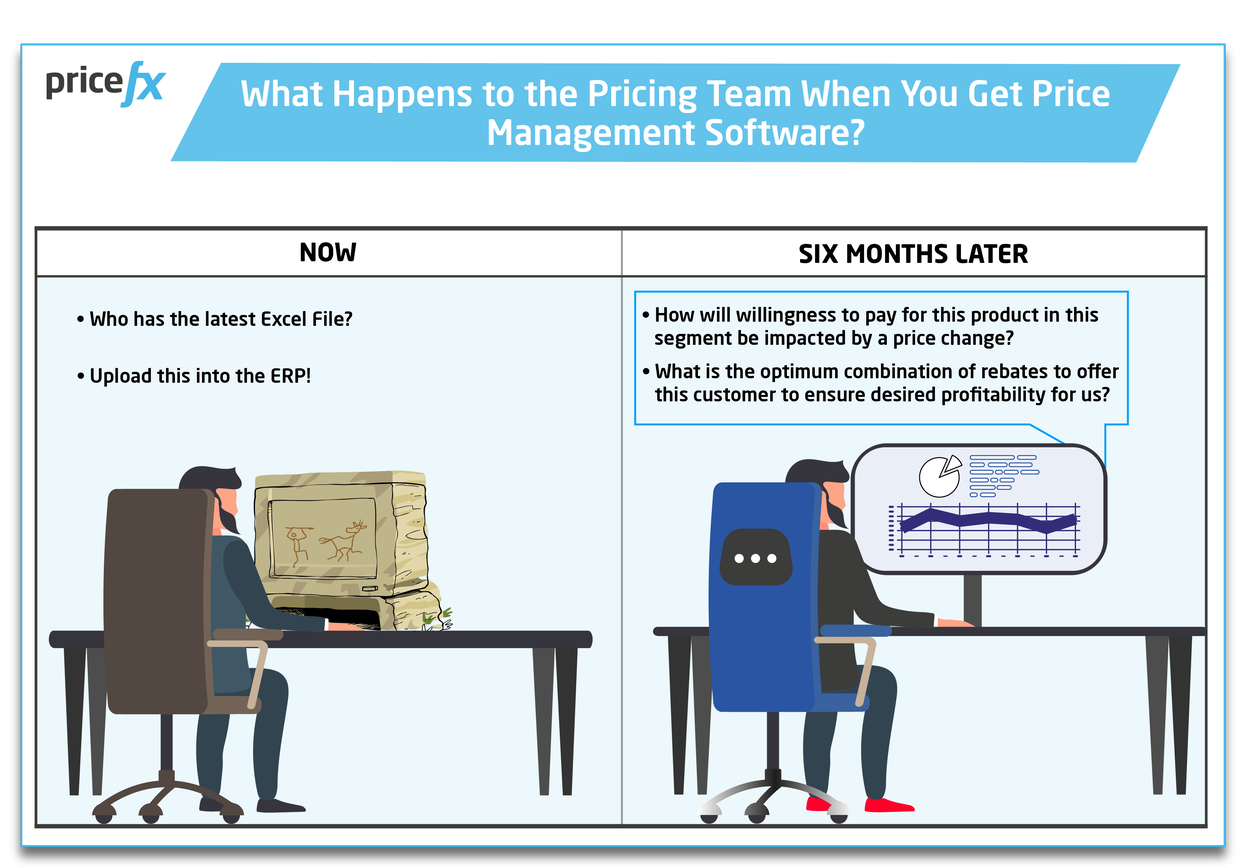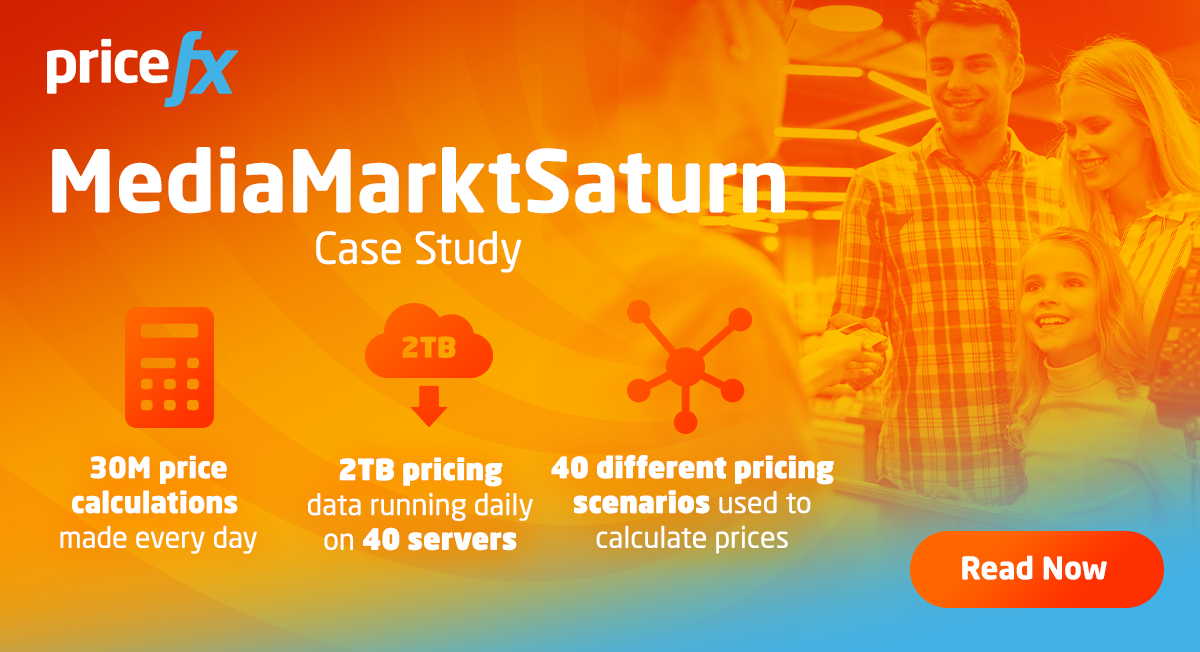In the ever-evolving world of e-commerce, pricing plays a pivotal role in determining the success of your business. To stay competitive and maximize profits, many e-commerce entrepreneurs turn to pricing software for assistance, and often those that do not can miss out on the potential benefits involved. But how can you be sure that your business will be one of those to prosper with the introduction of the innovative technology? In this article, we explore the pros and cons of using pricing software for e-commerce, equipping you with the knowledge your organization needs to make informed decisions that will propel your business forward.
At Pricefx, helping e-commerce businesses implement and make the most from their pricing software solutions is a major part of what we have done for more than a decade. Despite the current challenges of a shape-shifting and sometimes formidable economic climate, we’re assisting e-commerce businesses to identify opportunities to simultaneously improve consumer price perception whilst protecting profit margin by leveraging advanced, AI-informed pricing tools to create and support unified e-commerce pricing strategies.
Let’s delve into the world of pricing software in the e-commerce realm and explore both its remarkable advantages and potential drawbacks. By presenting a comprehensive view, we aim to equip you with a balanced understanding of pricing software’s potential in e-commerce. Let’s begin on the positive side of the ledger, shall we?
The Pros of Pricing Software for E-Commerce
Sure, for most e-commerce business running pricing through automated software will seem like a slam-dunk. Nonetheless, let’s take some time to analyze the considerable benefits that your e-commerce organization can gain by using pricing software. Something may pop up on the list that you have never considered using your pricing software for, or alternatively, present the solution to a business problem you have been trying to solve desperately without success:
1. Enhanced Pricing Accuracy
Pricing software utilizes advanced algorithms to analyze market trends, competitor pricing, and customer behavior. By leveraging this data, you can set optimal prices for your products, ensuring you remain competitive while maximizing profitability.
By running simulations based on different pricing models, you can identify the most profitable strategies and make informed decisions about pricing adjustments before your organization puts them into play, empowering you to take a proactive approach to pricing and uncover hidden opportunities for profit.
2. Time and Effort Savings
With pricing software, the manual and time-consuming process of monitoring and adjusting prices becomes automated. This frees up valuable time for you and your sales and pricing teams to focus on other essential aspects of your e-commerce business, such as marketing, customer engagement and discovering pockets of profit that you never knew you had.

3. Implementing Dynamic Pricing
Pricing software empowers you to implement dynamic pricing strategies. By dynamically adjusting prices in response to market fluctuations, demand patterns, and inventory levels, you can optimize revenue and profit margins dynamically adjusting your prices to maximize revenue and capture additional value, saving you money and increasing your profit.
For example, during periods of high demand, you can pivot prices based on seasonality .
What’s more, dynamic pricing enables online retailers to improve inventory management, reduce waste, and boost sales during slow periods.
It also allows retailers to respond quickly to changes in market conditions and maintain price consistency across multiple sales channels.
4. Identify Competitive Advantage
Accurate and dynamic pricing can give you a competitive edge in the crowded e-commerce landscape. By staying ahead of your competitors, you can attract more customers and increase market share, leading to business growth. Specifically, if you deal in brands and comparable products, with transparent markets like Amazon FBA (Fulfillment by Amazon), online marketplaces and comparison homepages)
For example, consider a scenario where you sell car parts online, including mufflers. With pricing software, you can make data-informed choices on market trends, competitor pricing, and customer behavior related to mufflers. By analyzing this information, the software can recommend an optimal price for the muffler based on factors such as demand, product features, and competitor pricing.
Consider for a moment your pricing software detects a surge in demand for a specific type of performance muffler due to a popular car modification trend. The software recognizes this trend and suggests increasing the price slightly to capitalize on the higher demand and the perceived value of the product.
On the other hand, if the software identifies intense competition in the market or a decrease in demand for a particular muffler model, it may recommend adjusting the price slightly lower to maintain competitiveness and attract more customers.
By dynamically adjusting the pricing of the mufflers based on real-time market insights provided by the software, you can effectively position your product in the market. This enables you to gain a competitive edge, attract more customers, and increase your market share and business growth.
5. Leverage Real-Time Insights
Accurate and dynamic pricing in real-time can give you a competitive edge in the crowded e-commerce landscape. By staying ahead of your competitors, you can attract more customers and increase market share, leading to business growth.
Additionally, the ability to identify market changes in real-time is crucial for preventing margin loss gaps and causing considerable damage to your organization’s bottom line. By swiftly closing these gaps, you can maintain profitability and mitigate any potential long-term negative effects on your financial health.
This proactive approach ensures that you are consistently adapting to market dynamics and optimizing your pricing strategies for maximum results.
6. Flexibility and Scalability
Pricing software offers flexibility and scalability, catering in particular to large enterprise-level business organizations. Pricing software can adapt to your specific needs and grow alongside your business as it expands nationally, globally and in turn, expands in its product and customer diversity.
Consider the example of an e-commerce platform specializing in electronic goods. With pricing software, the platform can easily handle a vast catalogue of electronic products, from smartphones and laptops to cameras and gaming consoles. As the platform expands its product offerings and customer base, the pricing software seamlessly accommodates the growing diversity of products and customers. It enables the platform to set competitive prices based on market demand, competitor analysis, and customer behavior, ensuring optimal pricing strategies that drive sales and maximize profitability. Whether the platform expands nationally or globally, the pricing software provides the flexibility and scalability needed to support its growth while maintaining a competitive edge.
Check out the case study below to see how one long-term Pricefx customer, European electronics giant, MediaMarktSaturn, has done exactly that:
7. Enhanced Customer Insights
Pricing software provides valuable insights into customer behavior and preferences. Through data analysis, you can identify patterns, trends, and customer segments that can inform your pricing strategies.
Understanding your customers’ willingness to pay, price sensitivity, and purchasing patterns enables you to tailor your pricing approach, offer personalized promotions, and deliver targeted pricing to different customer segments.
The Cons of Pricing Software for E-Commerce
While in general, pricing software will be of great benefit to an e-commerce business, there are situations where it is less required.
For example, if a retailer has a unique or high-demand product (like an I-Phone or a Soda Stream for instance) or another product that is not widely available elsewhere, they may not need to offer discounts or promotions to incentivize customers to make a purchase and prices can be set identically without differentiation across customer segments and geographies.
In these cases, pricing software may not be necessary. Other disadvantages of pricing software for e-commerce include:
1. Cost
Implementing pricing software comes at a cost, which may be a barrier for some small businesses with limited budgets or those types of organization that have products in high demand without any differentiations in price across segments.
In those types of business cases, it is essential to consider the return on investment and assess whether the benefits outweigh the expenses.
To learn more about the cost of pricing software, check out this insightful article below:
2. Learning Curve
Mastering pricing software requires time and effort. You and your team may need to undergo training to fully utilize its features and functionalities. This learning curve can be challenging for those with limited technical expertise, or equally those teams (particularly in IT for example) who may be time poor due to competing work priorities such as implementing a new ERP or CRM system etc.
3. Data Accuracy and Integration
Pricing software relies on accurate and up-to-date data for optimal performance. Ensuring data accuracy and integrating the software seamlessly with your existing systems may pose challenges and require additional resources (see the ‘Learning Curve’ section above).
If your organization lacks any of these key integration components, consider delaying a start with pricing software project until you do:
- Know your company’s goal or what business outcomes you expect out of your pricing software integration project.
- Have a significant and experienced IT Solutions Architect to organize and direct your IT Department, and to liaise with your pricing vendor’s Integration Team.
- Make sure your IT team has generated a sole source of ‘data truth’. The lack of ‘data’ truth is the most common form of integration project delay.
- Secure an internal Executive Level Sponsor.
4. User Adoption
One of the potential challenges when implementing pricing software for e-commerce is user adoption. While the software itself may offer a range of features and benefits, its effectiveness ultimately depends on how well your team embraces and utilizes it. User adoption refers to the willingness and ability of your employees to fully embrace the pricing software and integrate it into their daily workflow.
While automation streamlines pricing processes, it can also limit the individualized touch and intuition that human decision-making has provided in the past.
Some employees may resist the adoption of pricing software due to fear of job displacement, concerns about increased workload, or a general aversion to change.
Addressing these concerns, providing clear communication and training, and emphasizing the benefits and value the software brings can help overcome resistance and encourage user adoption.
But What Kind of Pricing Software Does My E-Commerce Business Need?
By carefully evaluating the above pros and cons, you can make an informed decision about whether pricing software is the right solution for your e-commerce business. Remember, every business is unique, so understanding your specific needs and aligning them with the capabilities of pricing software is crucial. With the right approach, pricing software can become a valuable asset in your quest for e-commerce excellence.
At Pricefx, we have helped hundreds of businesses over the last decade and more to select and configure the technological tools they require for pricing in their unique business model to meet their precise goals.
To learn more and walk through each of the 5 types of pricing software and explore what each does, how it does it, and the potential benefits they all can bring to your e-commerce business, check out the article below:
Or if you would like some assistance in selecting the best pricing software for your company, talk to one of our pricing experts today.
Happy Pricing!



